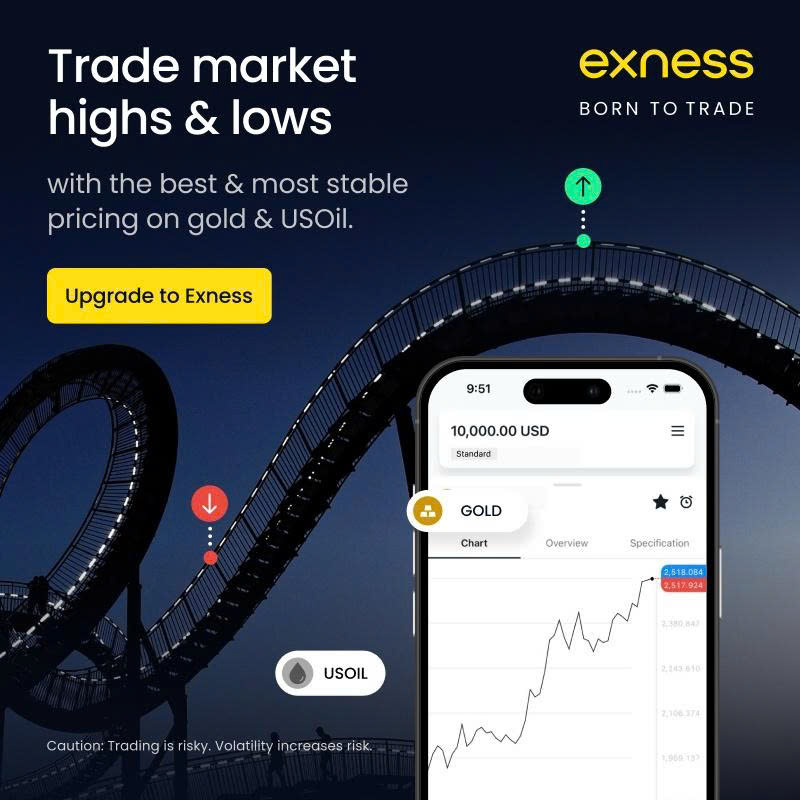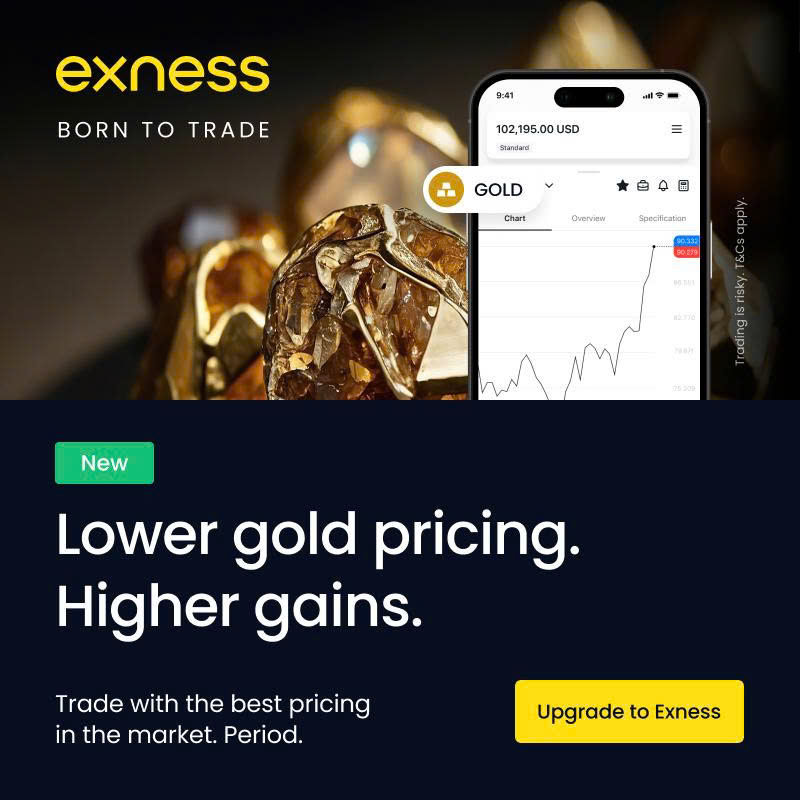
7 minute read
Exness vs Saxo Bank: Which Forex Broker Should You Choose?
from Exness
by Exness Blog
Choosing between Exness and Saxo Bank for your forex trading needs can feel like picking between two top-tier restaurants—both offer great food, but the vibe, menu, and price point cater to different tastes. If you’re wondering which broker is the better fit for your trading goals in 2025, this article breaks it down for you in a no-fluff way. We’ll compare Exness and Saxo Bank across key factors like regulation, platforms, fees, tradable assets, and customer support to help you decide. Let’s dive in!

✅ Trade with Exness now: Open An Account or Visit Brokers 👈
Overview: Exness vs Saxo Bank at a Glance
Exness, founded in 2008 and based in Cyprus, is a go-to for retail traders who love tight spreads, high leverage, and the familiar MetaTrader platforms. Saxo Bank, established in 1992 in Denmark, is a premium choice with a broader range of over 70,000 instruments and sophisticated proprietary platforms, appealing to advanced and institutional traders. Both are regulated and trustworthy, but they serve different crowds. Exness is beginner-friendly with low costs, while Saxo Bank is ideal for seasoned traders with deeper pockets.
Let’s break down the details so you can see which one aligns with your trading style.
1. Regulation and Trustworthiness
Trust is everything when you’re handing over your hard-earned cash to a broker. So, how do Exness and Saxo Bank stack up?
· Exness: Regulated by reputable authorities like the UK’s Financial Conduct Authority (FCA) and Cyprus’s CySEC, Exness also holds licenses from Tier-2 regulators like South Africa’s FSCA. Its Trust Score is 71/100, labeled “Average Risk,” due to fewer Tier-1 licenses compared to top-tier brokers. Exness segregates client funds and offers negative balance protection in some regions, which adds a layer of security.
· Saxo Bank: Saxo is a heavyweight here, regulated by multiple Tier-1 authorities, including the FCA, Australia’s ASIC, and Switzerland’s FINMA. It holds a Danish banking license and has a Trust Score of 99/100, earning a “Highly Trusted” label. Saxo’s client funds are protected up to €100,000 through the Danish Guarantee Fund, and its status as a Systemically Important Financial Institution (SIFI) underscores its financial stability.
Verdict: Saxo Bank wins for trustworthiness with its extensive regulatory oversight and banking status. Exness is solid but doesn’t match Saxo’s regulatory breadth. If safety is your top priority, Saxo is the safer bet.
2. Trading Platforms: Ease vs. Sophistication
Your trading platform is your cockpit—how intuitive and powerful it is can make or break your experience.
· Exness: Exness sticks to the industry-standard MetaTrader 4 (MT4) and MetaTrader 5 (MT5), which are loved for their robust charting, automated trading via Expert Advisors (EAs), and mobile accessibility. They also offer the Exness Terminal and a Social Trading app for copy trading, perfect for beginners or those who want to follow pro traders. These platforms are reliable but may feel limited for multi-asset trading.
· Saxo Bank: Saxo offers its proprietary platforms, SaxoTraderGO and SaxoTraderPRO. SaxoTraderGO is web-based, mobile-friendly, and packed with advanced charting and research tools. SaxoTraderPRO is a beast for high-volume traders, offering customizable workspaces and algorithmic trading options like VWAP and TWAP. Saxo also supports third-party platforms like TradingView and MT4 in some regions, giving you flexibility.
Verdict: Exness’s MetaTrader platforms are great for forex-focused traders and beginners, while Saxo’s platforms cater to advanced traders who want a multi-asset, customizable experience. If you’re new or forex-centric, Exness is simpler. For versatility, Saxo takes the crown.

✅ Trade with Exness now: Open An Account or Visit Brokers 👈
3. Fees and Costs: Where’s the Value?
Nobody wants their profits eaten up by fees. Let’s see how these brokers compare.
· Exness: Known for competitive spreads, Exness offers variable spreads that can be as low as 0 pips on its Zero account, though it comes with a fixed commission. The Standard account has no commission but wider spreads, making it beginner-friendly. There are no inactivity fees, and deposits/withdrawals are often free, though limited to methods like bank cards and Perfect Money. Exness’s low-cost structure makes it attractive for retail traders.
· Saxo Bank: Saxo’s fees are higher but tiered based on account type (Classic, Platinum, VIP). For example, forex spreads start at 0.9 pips for EUR/USD, and stock trading fees are around 0.08% with a $1 minimum. Currency conversion fees are competitive at 0.25%, especially for Swiss investors. However, Saxo’s high minimum deposit (€2,000 for Classic accounts) can be a barrier for beginners. No inactivity fees were introduced in 2024 for most regions, which is a plus.
Verdict: Exness is the budget-friendly choice, especially for smaller accounts or high-frequency traders. Saxo’s fees are better for high-volume traders with larger capital, but the high entry point might deter newbies.
4. Tradable Assets: Diversification Options
The more assets you can trade, the better you can diversify your portfolio.
· Exness: Exness focuses on forex (over 100 pairs), 34 cryptocurrencies, and CFDs on stocks, indices, metals, energies, and oil. It’s a solid lineup for forex and CFD traders but lacks depth in traditional assets like stocks and bonds.
· Saxo Bank: Saxo is a multi-asset powerhouse, offering over 70,000 instruments, including forex, stocks, bonds, ETFs, futures, options, and cryptocurrencies (via derivatives, not direct trading). You can trade on 50 global exchanges, making it ideal for those who want to diversify across asset classes.
Verdict: Saxo Bank dominates with its vast asset selection, perfect for traders who want exposure to multiple markets. Exness is great for forex and CFD fans but falls short for broader diversification.
5. Account Types and Accessibility
Different traders need different account structures. Let’s compare.
· Exness: Exness offers flexible account types:
Standard: No commission, wider spreads, great for beginners.
Standard Cent: Micro-lots for low-risk trading.
Pro: Tight spreads, low commissions for experienced traders.
Zero: Near-zero spreads with fixed commissions for high-frequency trading.These accounts have no or low minimum deposits, making Exness accessible to all.
· Saxo Bank: Saxo’s accounts are tiered:
Classic: No minimum deposit in some regions, but typically €2,000.
Platinum: $200,000 minimum, better pricing.
VIP: $1,000,000 minimum, premium services.Saxo’s high minimums make it less accessible for beginners, but the AutoInvest feature (for ETFs) and multi-currency accounts are great for long-term investors.
Verdict: Exness wins for accessibility with low or no minimum deposits and beginner-friendly accounts. Saxo is better for high-net-worth traders or those planning long-term investments.
6. Customer Support and Education
Good support and learning resources can make your trading journey smoother.
· Exness: Offers 24/7 multilingual support via email, phone, and live chat in some regions. Its educational resources include trading analysis tools, calculators, economic calendars, and webinars, but they’re not as comprehensive as top-tier brokers. Some users note limited deposit/withdrawal methods and a lack of advanced technical analysis tools.
· Saxo Bank: Provides 24/5 support via phone and email, but no live chat, which is a drawback. Saxo shines in education with its Help.Saxo portal, offering articles, video tutorials, webinars, and market analysis from the SaxoStrats team. The Saxo Market Call podcast and Global Market Quick Take reports are excellent for staying updated.
Verdict: Saxo Bank leads in educational resources, ideal for traders who want in-depth market insights. Exness offers solid support, especially for beginners, but its educational content is less robust.
Which Broker Should You Choose?
Here’s the bottom line:
· Choose Exness if: You’re a beginner or retail trader looking for low-cost trading, tight spreads, and simple platforms like MT4/MT5. It’s perfect for forex and CFD trading with low entry barriers.
· Choose Saxo Bank if: You’re an experienced or institutional trader with larger capital, seeking a wide range of assets, advanced platforms, and top-tier regulation. Saxo’s premium features suit those who want a sophisticated trading experience.
Both brokers are reliable, but your choice depends on your budget, trading style, and goals. Exness keeps it affordable and straightforward, while Saxo Bank offers a premium, multi-asset experience.
Final Thoughts
In 2025, Exness and Saxo Bank remain strong contenders in the forex and CFD trading world, but they cater to different needs. Exness is your friendly, budget-conscious option, while Saxo Bank is the high-end choice for serious traders. Weigh your priorities—whether it’s low costs, asset variety, or platform sophistication—and pick the one that feels right for you. Happy trading!
✅ Trade with Exness now: Open An Account or Visit Brokers 👈
Read more:










